Filmed April 1963
The irony of the situation didn’t escape me. I was well aware that a mere two months earlier the thought of turning down a directing assignment would have seemed total insanity. But there I was, doing exactly that. I was walking away from the assignment to direct another ROUTE 66 in Florida and was returning to Los Angeles to join the unemployment line at their building on Santa Monica Boulevard in Hollywood. Did I do the right thing? Absolutely! The producers were obviously pleased with the films I was delivering, so I felt that as exhausted as I was, I would not have been able to maintain that quality. Intuitively I didn’t want to lose the ground I had gained. There is a great legend about the superb Bert Lahr (the cowardly Lion in THE WIZARD OF OZ) that even at the height of his career, at the conclusion of any production he still lamented that he would never work again. And at that point in my career, having spent more days in that line on Santa Monica Boulevard than behind a camera, that was a fate that I had to realize was a real possibility. But the die was cast, so after a couple of days of resting I decided I would fly back to Iowa to spend Passover with my family. I made my air line reservations, packed my bags and off I flew. I wasn’t there two days when I received a telephone call from one of my agents.
“What are you doing there?” he asked.
“I’m going to spend Passover with my family. Why?”
“You’re supposed to be in New York. You’re booked to direct another NAKED CITY. They’re calling asking, ‘Where is he?’”
It seems that when I was released from the commitment to direct the ROUTE 66 in Florida, I had been rebooked to do a NAKED CITY. But nobody had told me. So I repacked my recently unpacked bags and caught the first flight I could to New York which was not that simple. Getting in and out of Mason City, Iowa, by air line was a formidable task. There was an occasional shuttle flight to Minneapolis, and from there I flew to New York.
Guess what? I arrived in New York to find just a very few pages of a screenplay by Alvin Sargent, COLOR SCHEMES LIKE NEVER BEFORE. A little deja vu? I learned the major roles had been cast. Marion Dougherty, casting director for both NAKED CITY and ROUTE 66, had obviously cast from the story synposis they must have sent her and possibly from conversations with Bert Leonard. The principle actors — Johnny Seven, Lou Antonio, Carol Rossen, Eugene Roche — were set so far. She would cast more people as script arrived.
So I, with the location manager, began the search for our locations. Again we were limited to looking for those in the few script pages we had received. Our principal location was going to be a brownstone, and it had to be a building that we would be able to access; characters would be entering and exiting the building. We went scouting in Greenwich Village and found a cul-de-sac street of brownstones that would work perfectly; we would be avoiding the traffic flow of a city throughway street. Although we didn’t have the script yet, we were told we would also need an apartment building across the street from our brownstone.
For the opening sequence we were going to need a cafeteria; that in New York was not a problem.
In Hollywood the woman at the table with Charlie would have been cast with a member of the Screen Extras Guild, who would have earned a salary bump for extra business. In New York members of SAG, the Screen Actors Guild, willingly took ‘extra’ assignments like this. After all it was work, and there was a pay check. The benefit for me was that she was an actress; her eyes never left the bowl of soup when it was set on the table, and she did that without any direction from me.
Bert called me soon after I arrived in New York. He told me that although Carmine and his two buddies were involved in a crime, they were not professional criminals; they were just ordinary blokes, a cabdriver, a baker and a plumber. My impression at the time was that they were the story’s main protagonists, an impression that would eventually be changed.
NAKED CITY was my first foray into police drama, and this was my third NAKED CITY. In the future I would direct another forty cop or detective shows, and I soon discovered the crime side of the story was always more interesting and exciting than the police procedures. But somehow NAKED CITY (Howard Rodman?) managed to write the scenes of the cops at work in a very intriguing way.
There was a scene between the two brothers at a construction site. We arrived at the location at the end of the afternoon when the construction crew was preparing to quit for the day. Johnny Seven, Carmine in our cast, knew some of the men on the crew, and he got them to stay on long enough to operate the equipment thus giving me an impressive shot to open the sequence. However when we shot the scene that followed, I couldn’t shoot in that direction again. The crew had left, and the machinery was dormant.
In the script Charlie’s packing was interrupted by a six page telephone sequence that concerned me. I worried about keeping a phone call that long interesting; and I was concerned that, should they want to shorten the sequence in the editing room, the coverage to do it should be there. I worried unnecessarily. In the final version of this scene nothing was eliminated.
Lou and Carol came to the set more than totally prepared. I think I remember that they had even rehearsed together before reporting for filming. I had seen Lou earlier in the year in a supporting role on Broadway in a lacklustre production of CAMILLE starring Susan Strasberg. Carol was from one of Hollywood’s royal families. Her father was the legendary Robert Rossen, with dozens of classic screenplays which he had written before he also began directing. His ten writer-director credits include screen classics ALL THE KING’S MEN and THE HUSTLER.
One fault I found with the New York crew was SOUND. On one pull back dolly two shot I did take one, which was not satisfactory. Then as we were preparing to repeat the scene for take two, I noticed the sound boom man was seated on the front of the dolly, reading a magazine, but not preparing to extend his microphone boom. When I questioned this, he replied, “Oh I already got it.” He also ended up getting it on take two.
I liked to film with two cameras whenever possible and was comfortable doing it because of my years on PLAYHOUSE 90 watching the use of multiple cameras on live television. The west coast directors of photography preferred, when using two cameras, to aim both cameras in the same direction. Jack Priestley surprised me when we did the restaurant scene by shooting in both directions. We shot both over shoulder shots of Lou and Carol at the same time. And we filmed both their close-ups at the same time. I thought it was great for the later editing process; in a restaurant eating scene it certainly minimized the chances of mismatched activity.
This show, like NARCISSUS ON AN OLD RED FIRE ENGINE, did not have a complete script when I began filming. New pages were arriving daily. Now one of the advantages of this was that we got to shoot much of the show in sequence. We had to. We shot the pages as they arrived. But there was a major disadvantage. When we originally booked Charlie’s brownstone, there was a time limit on when it would be available. After the first three or four days there was some reason we would no longer be able to go into the building. Well the new pages that were arriving kept including sequences to be filmed at the brownstone. Not only entrances and exits but some shots of Charlie in the upstairs window. Fortunately our production department was able to make the necessary arrangements so that we could continue using the building.
A fine actor, Allen Rich, was cast as the dispatcher. I know NAKED CITY did not have the ban on repeating actors like the one on STAR TREK. But I think they did limit appearances to one a season. Allen however was making his second appearance in this season; he had appeared as the cab driver in the parking space confrontation with Adam in ALIVE AND STILL A SECOND LIEUTENANT. I wonder if Marion cast him in this episode by reasoning that being a taxi dispatcher meant he was really playing the same character; he just had been promoted.
TIME! That was another problem caused by the lack of a complete script. It is the normal practice for a company, when it goes to a location, to film everything at that location before moving on. To load the equipment into the trucks, move to a new location and unload took at least an hour. We returned to the brownstone house street twice as I recall, possibly three times. Time spent moving is time lost filming.
Locations are always scouted before filming begins. But obviously we couldn’t do that since we didn’t have the complete script. I don’t remember how we ended up at the later locations in our story. Obviously the production department took us to the area they had selected, and I planned my staging and camera blocking as they unloaded the equipment.
On locations there always was a honey wagon, a long trailer of small dressing rooms for the actors (a room wasn’t set aside for the director until the late seventies) plus a couple of restrooms for the large crew. It was parked as close as possible to the site of filming, which was usually not very close. I recall this because on the final days of filming on the brownstone street I had a mild case of Montezuma’s revenge, Greenwich Village style. In desperation I had someone get me a bottle of Kaopectate which helped some, but not completely. I mention this to cast a shadow on the illusion of the glamour of filming and to show that filming is not always the magical adventure so many think it.
There wasn’t pressure to speed up as there probably would have been in any other production company, but since the studio knew the show was not being renewed for the next season, they did keep asking when our production office thought they would be wrapping. Our response was we would know better when we saw the rest of the script. Word came the final pages were on the way. They arrived, and I have to admit the last three and an eighth pages made me laugh. To begin with, it was another return to Greenwich Village to the brownstone house street, and the sheer size of the amount of work in those pages did not foresee an optimistic quick finishing. But since a picture is worth a thousand words, take a peek at my director’s script. In my script the page with my camera directions is opposite the script page. Since space here does not allow for that, the script page will come first followed by the camera directions page.


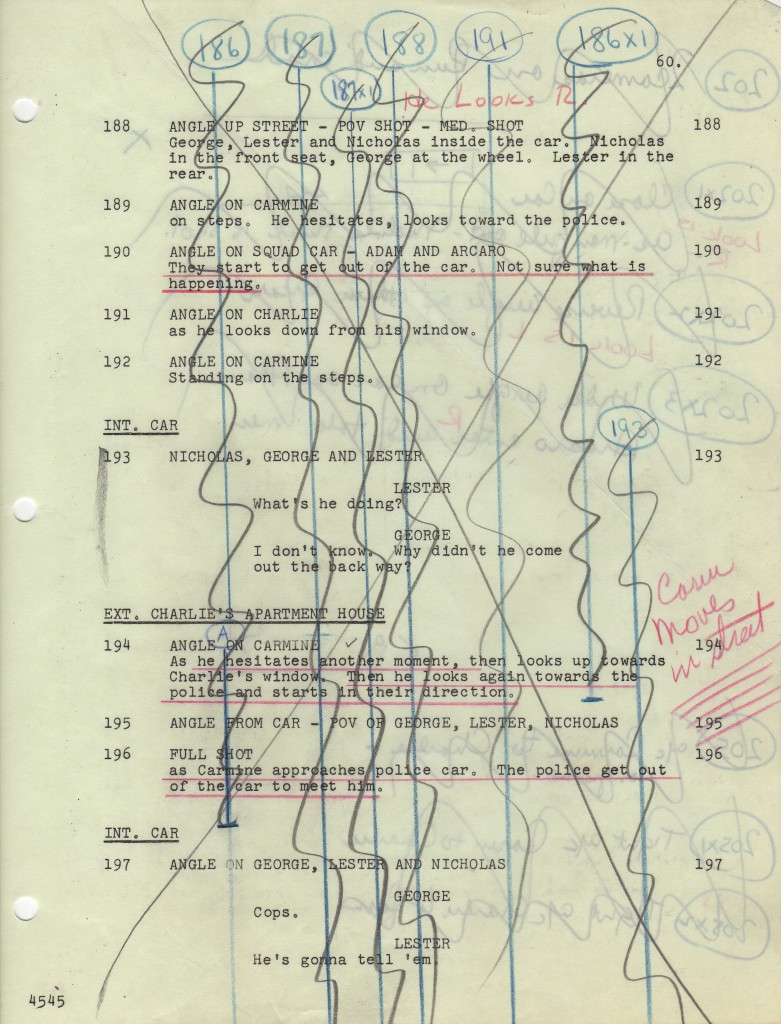
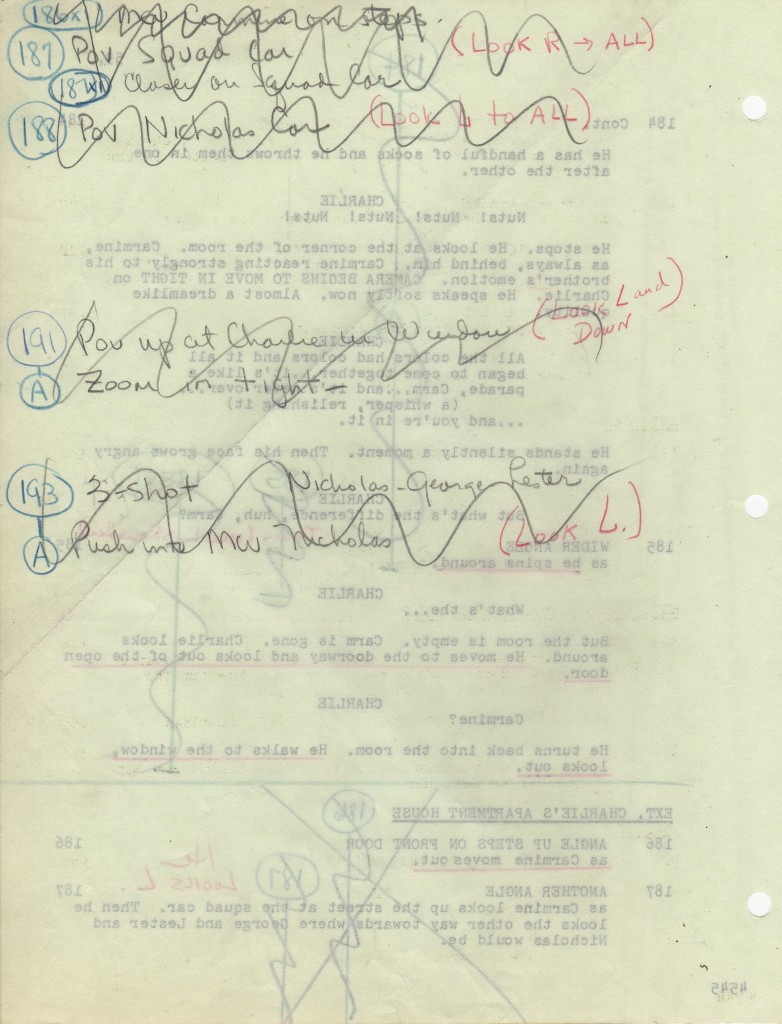
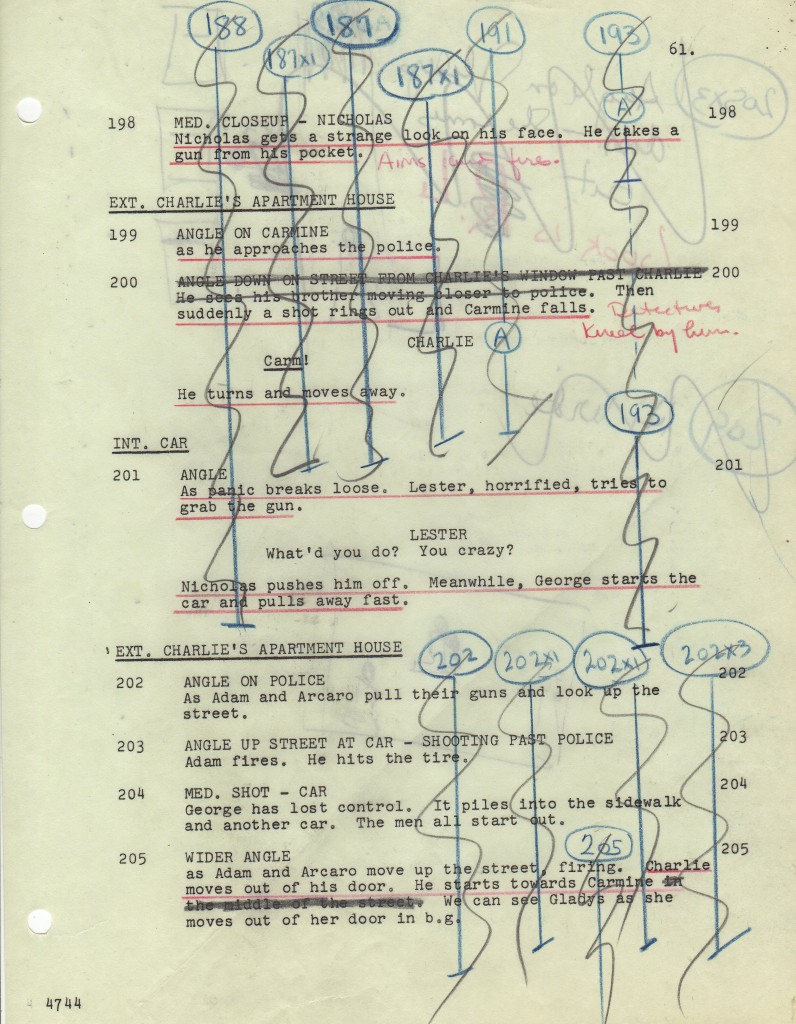
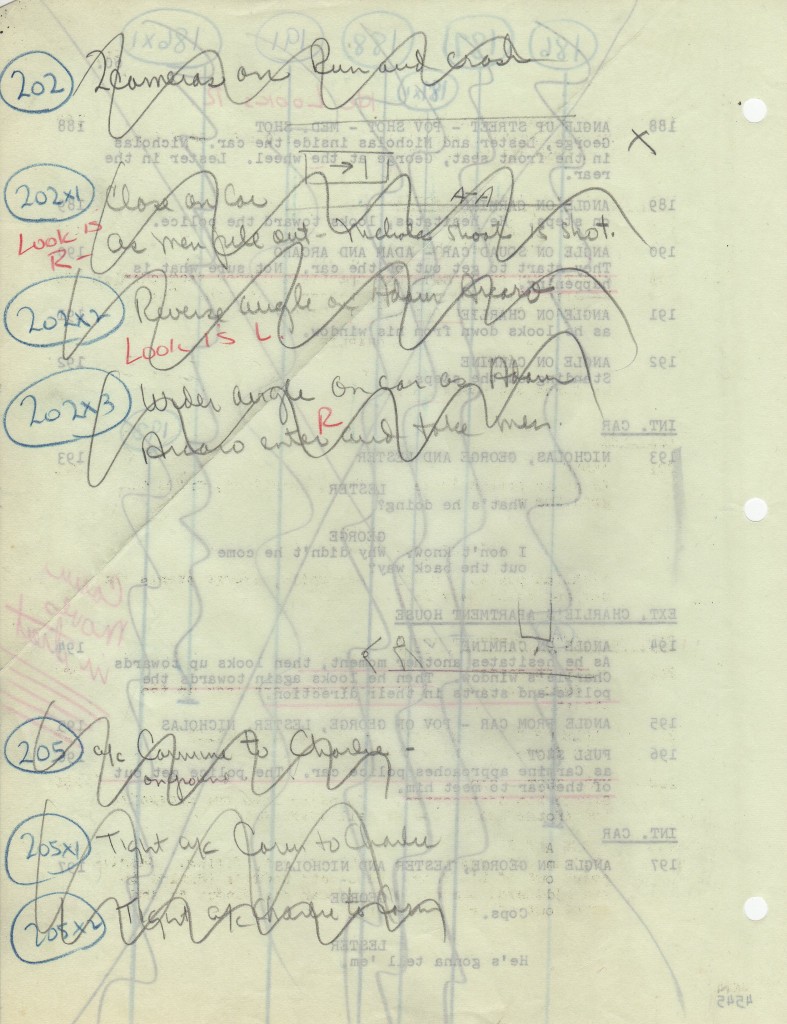
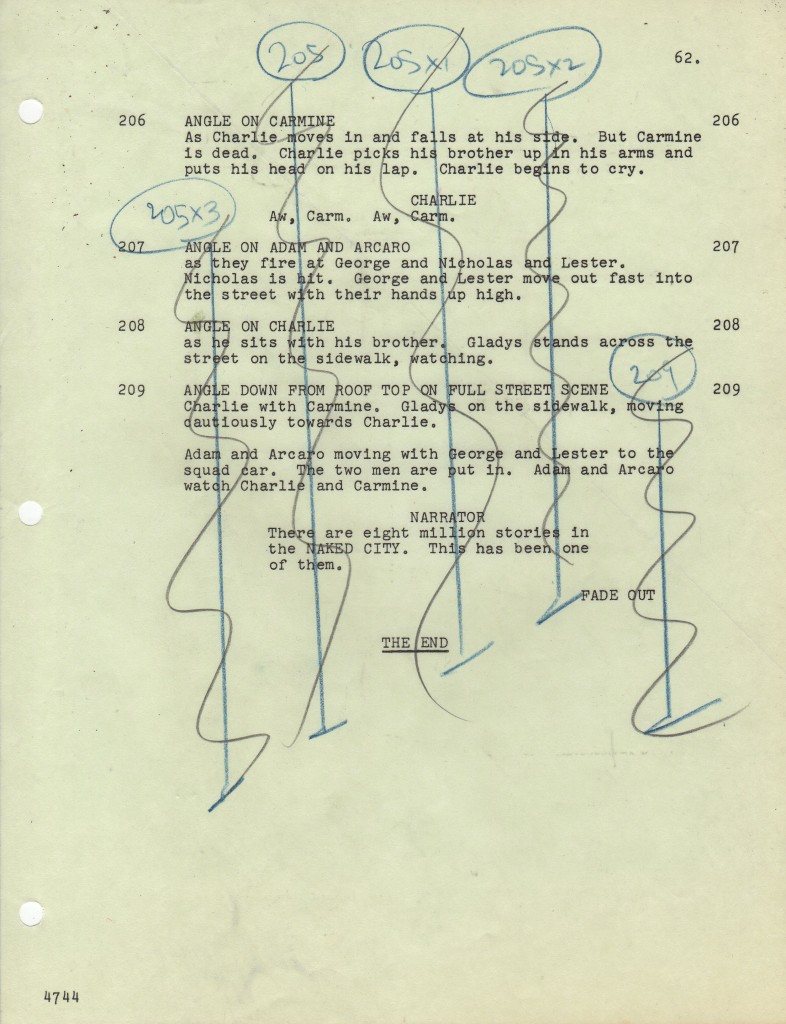
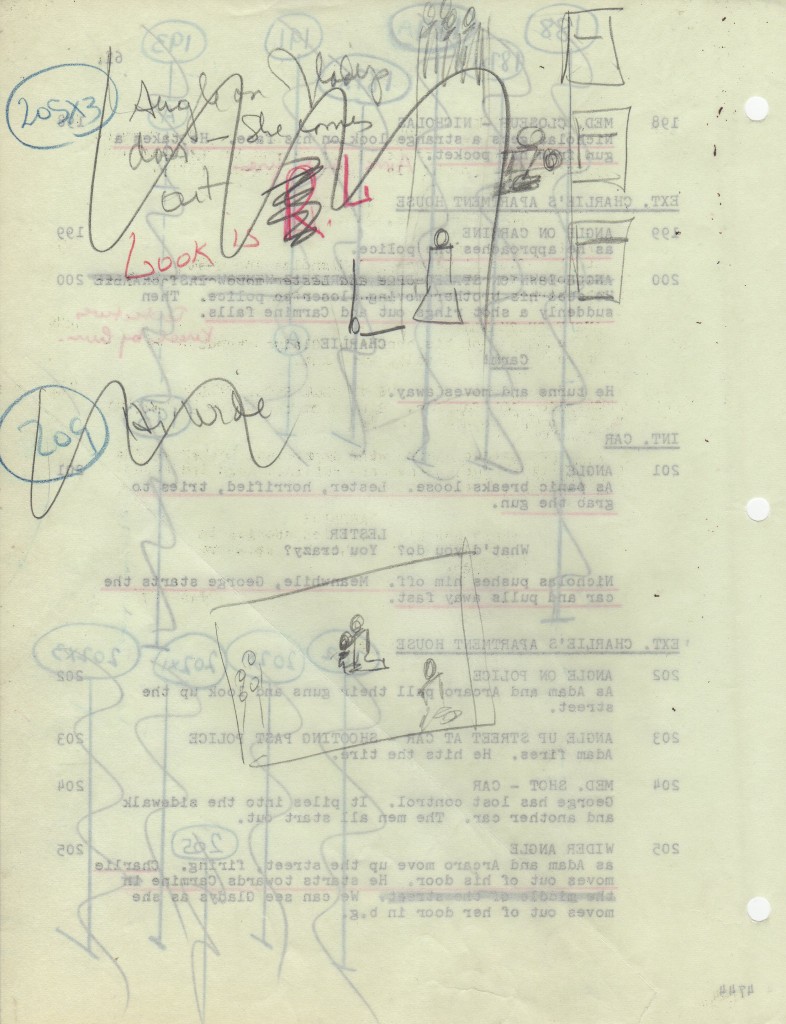
COLOR SCHEMES was scheduled to be filmed in seven days; it took eight days to complete. And so on April 16, 1963, the adventure that had begun on January 23 came to an end. In a period that spanned eighty-three days (forty-one of them in filming) I had directed five shows for Herbert Leonard, and they provided the final catalyst that sent me into a working career. He was a superb producer, and I was eternally grateful. But I never saw him again to tell him.
The journey continues



Was the police consulant for the show present during the filming of each episode? I imagine there had to be an officer (or retired officer) to consult on the scripts.
I was an advisor for the late author Stuart Kaminsky (I think he also wrote the script for the film Once Upon a Time in America) books in the Abe Lieberman series. Lieberman was an older Jewish sergeant teamed with a middle aged Catholic detective.
There were early plans for a t.v. show but unfortunately they fell through. My chance at the big-time.
Tom, I don’t remember there being a police consultant on the set. Whether there were any during the creating of the script I don’t know. Later on THE FBI there were two agents from the Bureau assigned to the series, one to be on the set at all times.
Ralph, I know you’re not a New York guy, but I’ll take a stab at this anyway. My Dad and I were watching this and could not identify the locations in the 14th video. We’re guessing the park was along the Hudson River. Riverside Park in upper Manhattan was our first guess, but there are smaller parks along the river in lower Manhattan, too. As for the ring of arches around the fountain, we’re totally clueless on that one. There seems to be a vehicle(?) moving from right to left above the arch at 3:27 to 3:29, as if a bridge or roadway were nearby.
I’m afraid I can’t help you out, Phil. I’m not that familiar with New York, and that problem was compounded by the fact that we didn’t have the entire script before filming began. I did not scout the location beforehand; I saw it the morning they took me there to film.
Thanks. A trip to the library may be necessary. When I get the answer, I’ll post it!
This was your best ‘Naked City’, but more on that later.
I agree with that last statement. COLOR SCHEMES was one of the best for all times. It was definitely the FIRST on that list.
I’ve got the location in the 14th video. It’s the 79th Street Rotunda, which is part of Riverside Park (built in 1937). From April thru October, this structure and the marina area to the west is used by the West 79th Street Boat Basin Café. I don’t know if the fountain is used during the off-months or if it still exists. The arches are supporting a traffic circle connected to exits off the Henry Hudson Parkway. You can get a great look at it using Google Maps satellite view.
Current-day pictures:
http://boatbasincafe.com/gallery.html
As I re-watched this episode tonight, it hit me like a ton of bricks when Charlie yelled “Gladys!” into the intercom in the 15th video. How did I miss this earlier…you were doing a beautiful, 85% faithful version of “On the Waterfront”!!!
The casting was perfect. All the scenes between Lou Antonio and Carol Rossen were smothered in REALISM. When people knowledgeable about the history of acting talk about the new techniques taught in the 1950s, I see what they mean in this episode. Was there any stuff like this coming off MGM’s assembly line in the 1930s?! I can identify small elements of Lou’s performance and say to myself, “Yeah, I’ve been there, too”.
As for Carol, she was only 25 when this was filmed, but she looked, sounded, and acted like an older woman here and in other shows (like ‘The Fugitive’ and ‘The Invaders’). This is no criticism – not every TV show needs an ingénue. In fact, she looked freakin’ good in “Color Schemes”…and thank you for those knockout close-ups of her in the 14th video.
Regarding Eugene Roche, I didn’t know this actor’s name, but as soon as I saw him I yelled, “It’s Mr. Ivory Liquid!” After further research, it turns out I was mistaken. I should have said, “It’s Mr. Ajax!” Despite numerous acting credits, all I remember of him is washing dishes in Ajax commercials.
Regarding the series narrator, Lawrence Dobkin, did you ever direct him in anything or know him? Wow, he had a lengthy career in front of AND behind the camera. Thanks.
Lawrence Dobkin was one of the very few directors that I did know, in spite of the fact that I never worked with him. He told me a classic Hollywood story. He was a young actor in Hollywood, fresh out of New York and cast in a film at 20th Century Fox being directed by Henry Hathaway. I think it may have been DIPLOMATIC COURIER. Larry reported early in the morning and was playing a Russian in the first scene scheduled that day. There was a rehearsal for the first setup, and after Larry’s first speech Hathaway stopped the rehearsal. He was furious. He said Larry’s Russian dialect was the worst he had ever heard. He demanded that casting immediately recast and send another actor to the set to replace Larry. Larry told me he was insulted by Hathaway’s tirade and would have left the set if the veteran assistant director hadn’t restrained him. While they awaited the arrival of the replacement, Hathaway called for a camera rehearsal to establish the marks so lighting could proceed. Larry said he told Hathaway he would proceed if the director would tell him why he was being fired. Hathaway responded, “That was the worst Russian accent I have ever heard.” Larry’s response was, “Mr. Hathaway, my parents were both born in Russian, what I was doing was a legitimate Russian accent.” Hathaway: “Well, it doesn’t sound like the Russian accents of the other actors in the cast.” Larry: “Who are the other actors?” The assistant director, standing nearby, named them, and Larry recognized immediately that those actors were Viennese. Larry said to Hathaway, “Oh, you mean you want the line to sound like this.” and he said his line with a Viennese accent. Hathaway responded, “Yes, that’s the Russian accent I want.” Problem solved and Larry stayed on the picture.
Ha ha, Walter Koenig had a similar situation. People question the accuracy of his accent on ‘Star Trek’ (“wessel” for vessel), but in an interview he said that’s how his Russian father spoke.
I didn’t know that about Walter. Now it’s my turn to say “Ha ha!” A friend of mine told me years ago that as a young bride she planned a special treat for her new husband, but ran into some difficulties when she went to the butcher shop. The butcher didn’t know what she wanted when she requested, “two thick weal chops.” That’s what her mother would have ordered.
According to Bob Justman, Joe Pevney found Walter Koenig for Star Trek. He told the producers, “he’s great for the part, but he has the worst Russian accent I’ve ever heard”.
There’s an anecdote, I guess you know it, when Michael Curtiz demanded a “poodle” from the prop man on the film set. Finally, after a long search, he delivered the dog. Curtiz looked at him: “What is that?” “A poodle!” “Oh, no, no! I said, a poodle. A poodle of water!”
Larry Dobkin also directed an episode of Star Trek early in the first season.
Ralph, I recently spotted Lawrence Dobkin in a ‘Playhouse 90’ episode called “The Plot to Kill Stalin” (broadcast Thu., 9/25/1958), and you were the Production Coordinator in the closing credits. Larry and the other actors didn’t use Russian accents for this one. It didn’t matter…what a great show it was!
The TV writer’s preview in the Pittsburgh Press lauded the make-up man as the real star, but didn’t mention his name – it was Bud Sweeney. He also commented on writer David Karp’s meticulous research, which included details like the model planes and tobacco tin on Stalin’s desk. He also said Karp spent several weeks in Europe with Russian refugees to absorb speech mannerisms. I wonder how he knew there were four(!) sets of double doors leading to the Red Army conference room. But, I bought it!
You can find the entire episode (with commercials) in two parts at http://www.archive.org. The only footage missing is the start of the opening credits, which included Douglas, Homolka, and Wallach. I noticed the closing credits included a separate “card” that only said ‘Jackie Gleason’. Why?
Was this episode broadcast live or pre-recorded? One source (ctva.biz) says “live”, but I’ve read that by 1958 many of the episodes were pre-recorded. How many days of rehearsal were needed for this production? Thanks.
BTW, congratulations on your comeback for ‘The Right Regrets’…the Phoenix rose again!
just now have discovered your wonderfully written and highly informative blog. THANK YOU for sharing your work and your recollections. This particular episode of Naked City was always one of my favorites- the work of Lou Antonio and Carol Rossen was stellar and still is. As is yours.
Oh, this was great. Such tight editing, too, no wasted dialogue or useless shots of NYC skylines. I can see a lot of challenges here, but it came out perfect. Thanks for recommending it, it’s another jewel in your directing crown. And OMG, those script pages look like a night- mare! How you came up with the finished product is a wonder, especially considering your intestinal problems. Damn, you’re good!
Thank you Sandy for those kind words. This was my 11th film production and I consider it my first really exceptional one. The script was by Alvlin Sargent, who went on to win 2 Academy Awards. He wrote it under great pressure. I didn’t get the final pages until I was in my 5th or 6th day of filming.